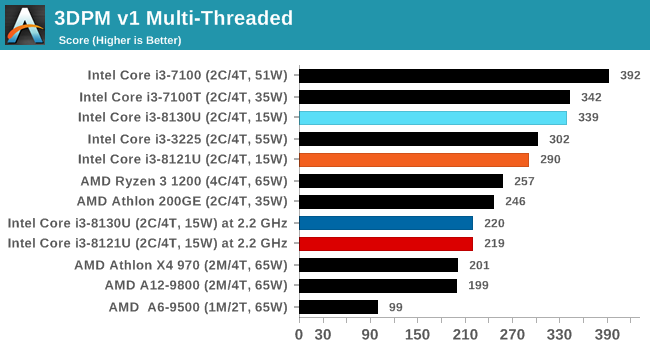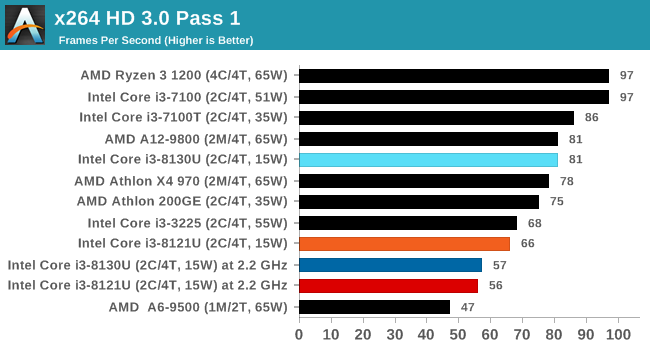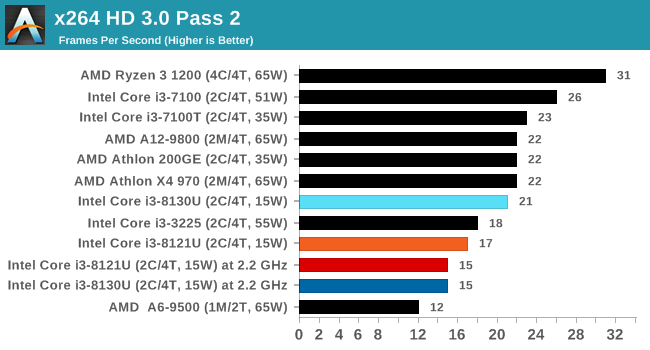Intel's 10nm Cannon Lake and Core i3-8121U Deep Dive Review
by Ian Cutress on January 25, 2019 10:30 AM ESTStock CPU Performance: Legacy Tests
We have also included our legacy benchmarks in this section, representing a stack of older code for popular benchmarks.
All of our benchmark results can also be found in our benchmark engine, Bench.
3DPM v1: Naïve Code Variant of 3DPM v2.1
The first legacy test in the suite is the first version of our 3DPM benchmark. This is the ultimate naïve version of the code, as if it was written by scientist with no knowledge of how computer hardware, compilers, or optimization works (which in fact, it was at the start). This represents a large body of scientific simulation out in the wild, where getting the answer is more important than it being fast (getting a result in 4 days is acceptable if it’s correct, rather than sending someone away for a year to learn to code and getting the result in 5 minutes).
In this version, the only real optimization was in the compiler flags (-O2, -fp:fast), compiling it in release mode, and enabling OpenMP in the main compute loops. The loops were not configured for function size, and one of the key slowdowns is false sharing in the cache. It also has long dependency chains based on the random number generation, which leads to relatively poor performance on specific compute microarchitectures.
3DPM v1 can be downloaded with our 3DPM v2 code here: 3DPMv2.1.rar (13.0 MB)


x264 HD 3.0: Older Transcode Test
This transcoding test is super old, and was used by Anand back in the day of Pentium 4 and Athlon II processors. Here a standardized 720p video is transcoded with a two-pass conversion, with the benchmark showing the frames-per-second of each pass. This benchmark is single-threaded, and between some micro-architectures we seem to actually hit an instructions-per-clock wall.












129 Comments
View All Comments
KOneJ - Sunday, January 27, 2019 - link
Bingo.Spunjji - Tuesday, January 29, 2019 - link
Truly magnificent.KateH - Saturday, January 26, 2019 - link
but please, if OP is interested in taking a whack at "articulating" i'd love to see what that looks like and how my translation faredMidwayman - Friday, January 25, 2019 - link
Interesing. So Basically no real possibility for desktop improvement until 2020 at least. They really are giving AMD a huge window to take the performance crown. Zen 2 is due to ship this year, right?BigMamaInHouse - Friday, January 25, 2019 - link
And dont forget- there are many Dual/Quad core (lets Say from Q6600 ~SandyBridge to 7700K ) Intel PC's that gonna be upgraded finally with new Ryzen launch and those PC won't we upgraded for another 3+ Years,DanNeely - Sunday, January 27, 2019 - link
The lower end of that range has been upgrading for years. The upper end has no real reason to upgrade unless they're doing something other than gaming, since current games don't benefit from the higher core counts much.I'm in the middle with a 4790K; and still see myself on track for a nominal 2022 upgrade; short of games growing CPU demands significantly or unexpected hardware failures I don't see any need to bring it forward. The additional cores will be nice for future proofing; but what I'm mostly looking forward to is all the stuff outside the CPU.
My notional want list is 10GB ethernet, PCIe4(5?) to the GPU and SSD, 50/50 USB 3.x A/C mix, and DDR5. The first of these is starting to show up on halo priced mobos.
PCIe4 is rumored to be launching this year on AMD, although from the leaks so far it's not clear if it'll only reach the first x16 slot for the GPU or be more widely available (maximum trace lengths are short enough that anything other than M.2 on a not-dimm will probably need signal boosters increasing costs).
Dual USB-C is starting to show up on a few boards; but widerspread availability is likely to be blocked until the hardware to handle flipping the connector moves from a separate chip into the chipset itself.
DDR5 is supposed to start shipping in very limited quantities this year, but will be another year or two before reaching consumer devices.
My guess is late 2020/early 2021 before all the hardware I want is finally available; which fits well with the nominal 8y lifespan I'm targeting for my systems core components.
shadowx360 - Friday, February 1, 2019 - link
What is the point of DDR5? It's going to be beyond overpriced at launch for negligible performance gain. As for USB-C, you can find cases with front connectors.Gondalf - Friday, January 25, 2019 - link
Ask to TSMC, we have not any real date of shipment. Moreover we don't know how the new SKUs will perform.eastcoast_pete - Saturday, January 26, 2019 - link
I don't think TSMC would give anybody except their customer (AMD) an expected shipping date. Also, while we don't know how the new AMD processors will perform, we already know that I Intel's 10 nm tech was both late and hasn't performed so we'll. BTW, I am currently running all PCs around me on Intel chips, so no fanboy here. This disappointing 10 nm fiasco is bad for all of us, as we need Intel to egg on AMD and vice versa. If one of them drops behind, the other one gets lazy.eastcoast_pete - Saturday, January 26, 2019 - link
Damn autocorrect and no edit!